本文为Varlet组件库源码主题阅读系列第七篇,读完本篇,可以了解到如何通过unplugin-vue-components插件来为你的组件库实现按需引入。
手动引入
前面的文章中我们介绍过Varlet组件库的打包流程,最后会打包成几种格式,其中module和commonjs格式都不会把所有组件的代码打包到同一个文件,而是保留着各个组件的独立,每个组件都导出作为一个Vue插件。
第一种按需使用的方法是我们手动导入某个组件并进行注册:
import {
createApp } from 'vue'
import {
Button } from '@varlet/ui'
import '@varlet/ui/es/button/style/index.js'
createApp().use(Button)
Button组件并不是从它的自身目录中引入的,而是从一个统一的入口,@varlet/ui包的package.json中配置了两个导出入口:

按需引入,也可以理解成是tree shaking,它依赖于ES6模块,因为ESM模块语法是静态的,和运行时无关,只能顶层出现,这就可以只分析导入和导出,不运行代码即可知道模块导出的哪些被使用了哪些没有,没有用到的就可以被删除。
所以想要支持按需引入那么必然使用的是module入口,这个字段目前各种构建工具应该都是支持的,module入口它是个统一的入口,这个文件中显然导出了所有组件,那么比如我们只导出Button组件,其他没有用到的组件最终是不是不会被打包进去呢,实际上并没有这么简单,因为有的文件它会存在副作用,比如修改了原型链、设置了全局变量等,所以虽然没有显式的被使用,但是只要引入了该文件,副作用就生效了,所以不能被删除,要解决这个问题需要在package.json中再配置一个sideEffects字段,指明哪些文件是存在副作用的,没有指明的就是没有副作用的,那么构建工具就可以放心的删除了:
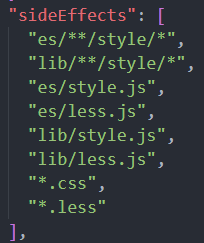
可以看到Varlet告诉了构建工具,这些样式文件是有副作用的,不要给删除了,其他文件中没有用到的模块可以尽情删除。
自动引入
如果你觉得前面的手动引入比较麻烦,Varlet也支持自动引入,这个实现依赖的是unplugin-vue-components插件,这个插件会扫描所有声明在模板中的组件,然后自动引入 组件逻辑 和 样式文件 并 注册组件。
在Vite中的配置方式:
import vue from '@vitejs/plugin-vue'
import components from 'unplugin-vue-components/vite'
import {
VarletUIResolver } from 'unplugin-vue-components/resolvers'
import {
defineConfig } from 'vite'
export default defineConfig({
plugins: [
vue(),
components({
resolvers: [VarletUIResolver()]
})
]
})
如果想要这个插件支持你的组件库,需要编写一个解析器,也就是类似上面的VarletUIResolver,如果想要给更多人用就需要提个pr,这个插件目前已经支持如下这些流行的组件库:
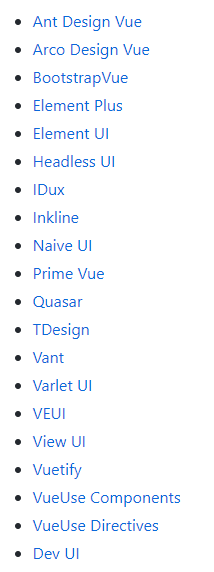
以VarletUIResolver为例来看一下这个解析器都做了什么:
// unplugin-vue-components/src/core/resolvers/varlet-ui.ts
const varDirectives = ['Ripple', 'Lazy']
export function VarletUIResolver(options: VarletUIResolverOptions = {
}): ComponentResolver[] {
return [
{
type: 'component',
resolve: (name: string) => {
const {
autoImport = false } = options
if (autoImport && varFunctions.includes(name))
return getResolved(name, options)
if (name.startsWith('Var'))
return getResolved(name.slice(3), options)
},
},
{
type: 'directive',
resolve: (name: string) => {
const {
directives = true } = options
if (!directives)
return
if (!varDirectives.includes(name))
return
return getResolved(name, options)
},
},
]
}
执行VarletUIResolver方法会返回一个数组,unplugin-vue-components支持自动导入组件和指令,所以可以看到上面返回了两种解析方法,虽然目前我们没有看到unplugin-vue-components的源码,但是我们可以猜想unplugin-vue-components在模板中扫描到某个组件时会调用type为component的resolve,扫描到指令时会调用type为directive的resolve,如果解析成功,那么就会自动添加导入语句。
当扫描到的组件名以Var开头或扫描到Varlet的指令时,两个解析方法最后都会调用getResolved方法:
// unplugin-vue-components/src/core/resolvers/varlet-ui.ts
export function getResolved(name: string, options: VarletUIResolverOptions): ComponentResolveResult {
const {
importStyle = 'css',
importCss = true,
importLess,
autoImport = false,
version = 'vue3',
} = options
// 默认是vue3版本
const path = version === 'vue2' ? '@varlet-vue2/ui' : '@varlet/ui'
const sideEffects = []
// 样式导入文件
if (importStyle || importCss) {
if (importStyle === 'less' || importLess)
sideEffects.push(`${
path}/es/${
kebabCase(name)}/style/less.js`)
else
sideEffects.push(`${
path}/es/${
kebabCase(name)}/style`)
}
return {
from: path,
name: autoImport ? name : `_${
name}Component`,
sideEffects,
}
}
函数的返回值是一个对象,包含三个属性:组件的导入路径、导入名称、以及一个副作用列表,里面是组件的样式导入文件。
你可能会对组件的导入名称格式_${name}Component有点疑惑,看一下Varlet的导出方式,以Button组件为例,它的导出文件如下:

默认导出了组件之外还通过_ButtonComponent名称又导出了一份,然后看看@varlet/ui整体的导出文件:
import Button, * as ButtonModule from './button'
export const _ButtonComponent = ButtonModule._ButtonComponent || {
}
function install(app) {
Button.install && app.use(Button)
}
export {
install,
Button,
}
export default {
install,
Button,
}
所以_${name}Component格式导出的就是ButtonModule._ButtonComponent,为什么要这么做呢,为什么不直接从:
export {
install,
Button,
}
中导入Button呢,按理说应该也是可以的,其实是因为Varlet有些组件默认的导出不是组件本身,比如ActionSheet:
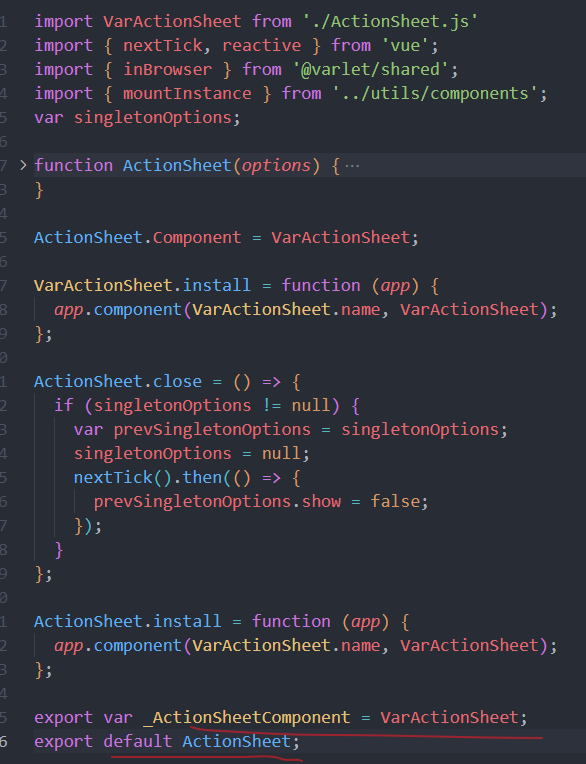
默认导出的是一个函数,根本不是组件本身,那么显然不能直接在模板中使用。
接下来以在Vite中的使用为例来大致看一下unplugin-vue-components的实现原理。
浅析unplugin-vue-components
import components from 'unplugin-vue-components/vite'导入的components是createUnplugin方法执行的返回值:
import {
createUnplugin } from 'unplugin'
export default createUnplugin<Options>((options = {
}) => {
const filter = createFilter(
options.include || [/\.vue$/, /\.vue\?vue/, /\.vue\?v=/],
options.exclude || [/[\\/]node_modules[\\/]/, /[\\/]\.git[\\/]/, /[\\/]\.nuxt[\\/]/],
)
const ctx: Context = new Context(options)
const api: PublicPluginAPI = {
async findComponent(name, filename) {
return await ctx.findComponent(name, 'component', filename ? [filename] : [])
},
stringifyImport(info) {
return stringifyComponentImport(info, ctx)
},
}
return {
api,
transformInclude(id) {
return filter(id)
},
async transform(code, id) {
if (!shouldTransform(code))
return null
try {
const result = await ctx.transform(code, id)
ctx.generateDeclaration()
return result
}
catch (e) {
this.error(e)
}
},
//...s
}
})
unplugin是一个构建工具的统一插件系统,也就是写一个插件,支持各种构建工具,目前支持以下这些:

createUnplugin方法接收一个函数为参数,最后会返回一个对象,可以从这个对象中获取用于各个构建工具的插件:
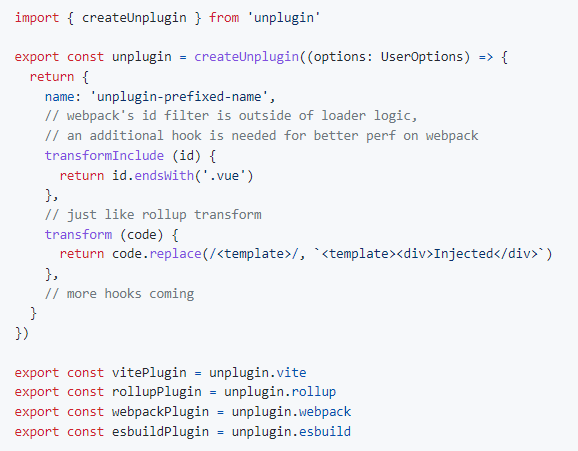
传入的函数会返回一个对象,其中transformInclude配置默认只转换.vue文件,transform为转换的核心方法,接收unplugin-vue-components插件之前的其他插件处理过后的Vue文件内容和文件路径作为参数,函数内调用了ctx.transform方法,这个方法又调用了transformer方法:
export default function transformer(ctx: Context, transformer: SupportedTransformer): Transformer {
return async (code, id, path) => {
ctx.searchGlob()
const sfcPath = ctx.normalizePath(path)
// 用文件内容创建一个魔术字符串
const s = new MagicString(code)
// 转换组件
await transformComponent(code, transformer, s, ctx, sfcPath)
// 转换指令
if (ctx.options.directives)
await transformDirectives(code, transformer, s, ctx, sfcPath)
// 追加一个注释内容:'/* unplugin-vue-components disabled */'
s.prepend(DISABLE_COMMENT)
// 将处理完后的魔术字符串重新转换成普通字符串
const result: TransformResult = {
code: s.toString() }
if (ctx.sourcemap)
result.map = s.generateMap({
source: id, includeContent: true })
return result
}
}
创建了一个MagicString,然后调用了transformComponent方法:
export default async function transformComponent(code: string, transformer: SupportedTransformer, s: MagicString, ctx: Context, sfcPath: string) {
const results = transformer === 'vue2' ? resolveVue2(code, s) : resolveVue3(code, s)
// ...
}
unplugin-vue-components同时支持Vue2和Vue3,我们看一下Vue3的转换,调用的是resolveVue3方法:
const resolveVue3 = (code: string, s: MagicString) => {
const results: ResolveResult[] = []
for (const match of code.matchAll(/_resolveComponent[0-9]*\("(.+?)"\)/g)) {
const matchedName = match[1]
if (match.index != null && matchedName && !matchedName.startsWith('_')) {
const start = match.index
const end = start + match[0].length
results.push({
rawName: matchedName,
replace: resolved => s.overwrite(start, end, resolved),
})
}
}
return results
}
我们使用Vue3官方的在线playground来看一下Vue单文件的编译结果,如果我们没有导入组件就在模板中引用组件,那么编译结果如下:
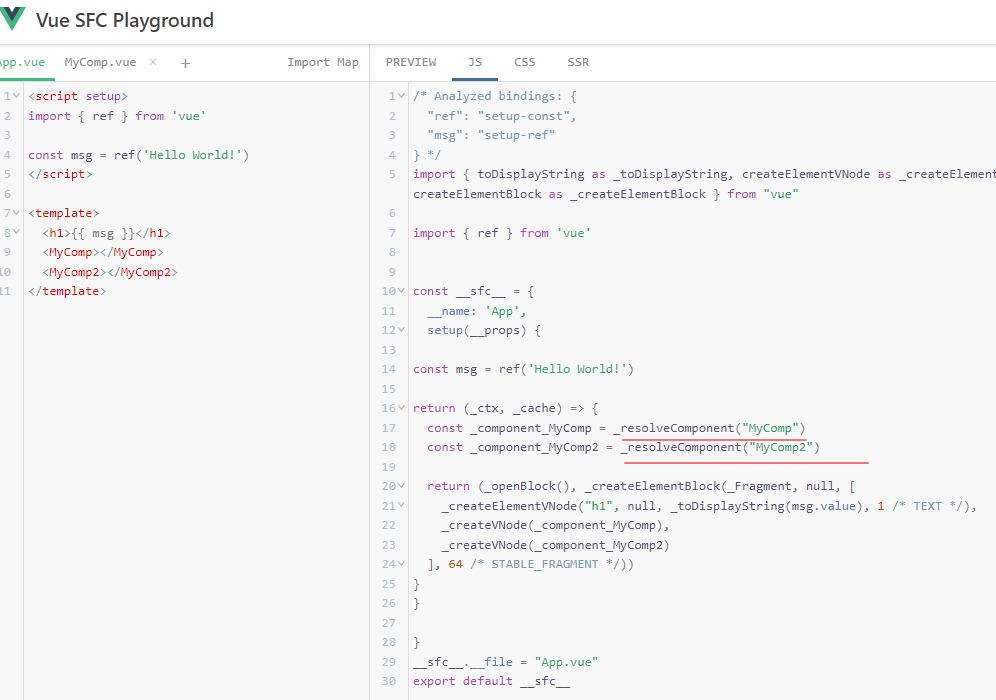
可以看到编译后的setup函数返回的渲染函数中生成了const _component_MyComp = _resolveComponent("MyComp")这行代码用来解析组件,那么前面的resolveVue3方法里的正则/_resolveComponent[0-9]*\("(.+?)"\)/g的含义就很明显了,就是用来匹配这个解析语句,参数就是组件的名称,所以通过这个正则会找出所有引用的组件,并返回一个对应的替换方法,回到transformComponent方法:
export default async function transformComponent(code: string, transformer: SupportedTransformer, s: MagicString, ctx: Context, sfcPath: string) {
// ...
for (const {
rawName, replace } of results) {
const name = pascalCase(rawName)
ctx.updateUsageMap(sfcPath, [name])
const component = await ctx.findComponent(name, 'component', [sfcPath])
// ...
}
}
遍历模板引入的所有组件,调用了ctx.findComponent方法:
async findComponent(name: string, type: 'component' | 'directive', excludePaths: string[] = []): Promise<ComponentInfo | undefined> {
// custom resolvers
for (const resolver of this.options.resolvers) {
if (resolver.type !== type)
continue
const result = await resolver.resolve(type === 'directive' ? name.slice(DIRECTIVE_IMPORT_PREFIX.length) : name)
if (!result)
continue
if (typeof result === 'string') {
info = {
as: name,
from: result,
}
}
else {
info = {
as: name,
...normalizeComponetInfo(result),
}
}
if (type === 'component')
this.addCustomComponents(info)
else if (type === 'directive')
this.addCustomDirectives(info)
return info
}
return undefined
}
这个方法里就会调用组件库自定义的解析器,如果某个组件被成功解析到了,那么会将结果保存起来并返回。
回到transformComponent方法:
export default async function transformComponent(code: string, transformer: SupportedTransformer, s: MagicString, ctx: Context, sfcPath: string) {
// ...
let no = 0
for (const {
rawName, replace } of results) {
// ...
if (component) {
const varName = `__unplugin_components_${
no}`
s.prepend(`${
stringifyComponentImport({
...component, as: varName }, ctx)};\n`)
no += 1
replace(varName)
}
}
}
组件如果被解析到了,那么会调用stringifyComponentImport方法创建导入语句并追加到文件内容的开头,注意组件的导入名称被命名成了__unplugin_components_${no}格式,为什么不直接使用组件原本的名字呢,笔者也不清楚,可能是为了防止用户自己又导入了组件导致重复吧:
export function stringifyComponentImport({
as: name, from: path, name: importName, sideEffects }: ComponentInfo, ctx: Context) {
path = getTransformedPath(path, ctx.options.importPathTransform)
const imports = [
stringifyImport({
as: name, from: path, name: importName }),
]
if (sideEffects)
toArray(sideEffects).forEach(i => imports.push(stringifyImport(i)))
return imports.join(';')
}
export function stringifyImport(info: ImportInfo | string) {
if (typeof info === 'string')
return `import '${
info}'`
if (!info.as)
return `import '${
info.from}'`
else if (info.name)
return `import { ${
info.name} as ${
info.as} } from '${
info.from}'`
else
return `import ${
info.as} from '${
info.from}'`
}
这个方法会根据info的类型拼接导入语句,VarletUIResolver解析器最后返回的是from、name、sideEffects三个字段,所以调用stringifyImport方法时会走第三个分支,以前面截图中的为例,结果如下:
import {
MyComp as __unplugin_components_0 } from 'xxx'
import {
MyComp2 as __unplugin_components_1 } from 'xxx'
另外也可以看到副作用列表sideEffects也被导入了,实际上就是组件的样式导入文件。
transformComponent方法最后调用replace(varName)方法将/_resolveComponent[0-9]*\("(.+?)"\)/匹配到的内容改成了__unplugin_components_${no},还是前面截图中的为例:
const _component_MyComp = _resolveComponent("MyComp")
const _component_MyComp2 = _resolveComponent("MyComp2")
被改成了:
const _component_MyComp = __unplugin_components_0
const _component_MyComp2 = __unplugin_components_1
到这里Vue3组件的导入语句就添加完成了,也能正常传递到渲染函数中进行使用,Vue2的转换和指令的转换其实也大同小异,有兴趣的可以自行阅读源码。
关于组件库的按需引入笔者之前还单独写过一篇,有兴趣的也可以看一下:浅析组件库实现按需引入的几种方式。